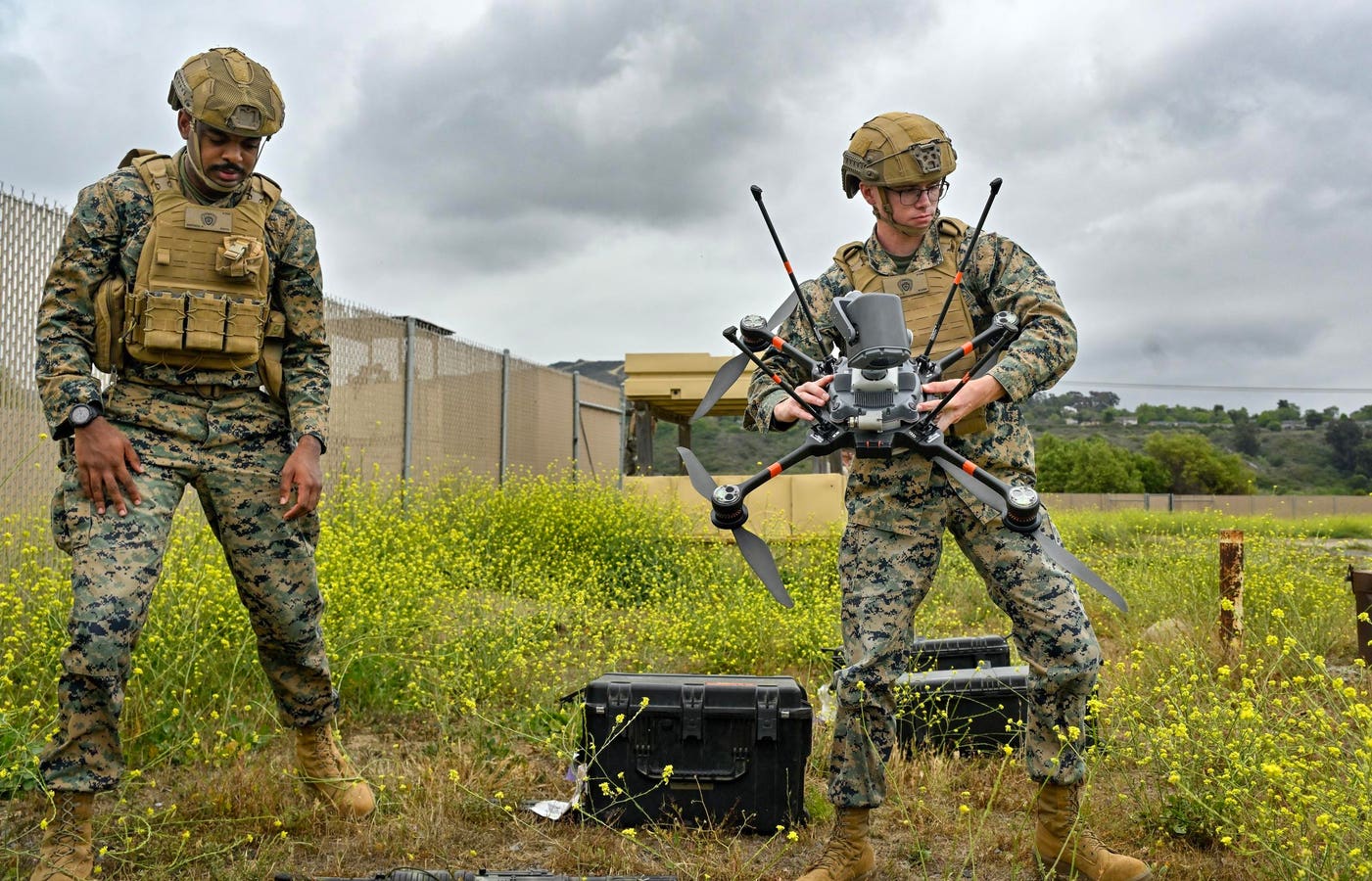U.S, Marines prepare to launch a drone in an exercise at Camp Pendleton in June 2025.
A new 1st Marine Division handbook shows how the Corps has modernized its thinking and is preparing to fight a drone war. It also reveals how far there is to go, not just in developing doctrine and training but also in acquiring the sort of hardware that Russia and Ukraine have been using for years. As a representative explained, getting the handbook out to establish foundational principles and mark out the way forward was vital even though is not complete.
And taking on the new realities of the drone battlefield is a real milestone.
“Overall, this is indeed a big leap forward for the USMC,” Samuel Bendett, an expert on drones and advisor to the CNA, CNAS and CAIS thinktanks told me. “The United States military has taken some time to observe, evaluate and attempt to codify tactics and concepts.”
Running With The Fist Draft
The 1st Marine Division Schools sUAS / CUAS Integration Handbook is a 90-page guide to drone and counter-drone warfare. This is not quite the first of its type; technically it updates and adds to a previous document published by 1st Marine Division in 2023, partly as a result of development of the units own training courses.
The handbook breaks new ground in U.S. small drone warfare
“This handbook is now the result of many contributions from beyond 1st Marine Division, and represents some of the current best thinking on how to fight with sUAS [small Uncrewed Aerial Systems] as part of a combined-arms force that achieves decision on today’s battlefields,” a representative of 1st Marine Division told me.
As might be expected, it one draws on learnings from Ukraine, and is still a work in progress.
“When we decided to take what had been a running draft document and publish it as a first edition, we didn’t put a ‘Conclusion’ at the end—because the only thing to conclude right now is that there is much more work to be done,” says the representative. “Instead, we put a ‘Way Ahead’ section that highlights what we think are the next priorities for tactical development.”
The document is written in the dense, acronym-rich jargon common to military handbooks, and there is plenty of solid material. It describes in detail the various drone missions from RSTA (‘Reconnaissance, Surveillance and Target Acquisition’) to One-Way Strike (the familiar FPV drones from Ukraine) and Two-Way Strike (bomber drones that return for reuse), as well as logistics. It describes how these drones give units their own air power, undertaking missions which would previously have required air support.
“GCE sUAS [i.e. drones operated by ground units] will almost certainly fulfill a large portion of previous requirements for manned aviation close air support,” says the handbook.
Even simple-seeming drone operations can require complex organization and an understanding of the … More
Unlike in Ukraine the drones will need to operate in the same airspace as close support aircraft and helicopters. In that conflict combat aircraft stay well behind the front lines and lob rockets glide bombs from long range. New approaches are needed, and the handbook goes into detail describing the mechanics of ‘hot walls’, ‘pizza slices’ and ‘kill boxes’ which ensure that uncrewed aircraft do not present a hazard to friendly ground forces or aircraft.
The handbook also covers aspects like ground checks and the “5-line Attack-Drone Strike Brief” a standardized format for requesting drone strikes, drawing on previous protocols for calling strikes from attack aircraft and helicopter gunships.
The Handbook is also notable though for what is not in it.
The Missing Pieces
The chapter on two-way attack drones notes that “The Marine Corps currently lacks dedicated systems of this type, and employment TTPs [Tactics, techniques and Procedures] remain nascent.”
Ukraine has been using bomber drones, nicknamed Baba Yagas buy the Russians, for more than three years, knocking out tanks and fortifications in night attacks, as well as commercial drones modified to drop grenades.
The R80 Skyraider adapted for bombing with SPAM-A attachment, in this case loaded with smoke … More
The Marine Corps lacks such assets, so instead the Handbook goes on to describe how the R80D SkyRaider scout drone can be modified for bombing with the SkyRaider Payload and Marking Attachment (SPAM-A), a 3D-printed gadget attached to the drone’s legs with zip ties. SPAM-A has five cylinders with trap doors. Each cylinder can be loaded with a water balloon, tennis ball or flash bang. For live operations grenades are used, a potentially hazardous process.
“Fragmentation grenades should be loaded upright to enable careful manipulation of safety mechanisms,” says the Handbook. “Once all grenades are loaded into their cylinders, then for each grenade: remove the pin and observe to ensure the spoon is retained in place by the cylinder. In the remote chance that the spoon is not retained, take immediate cover in the parapet as the grenade will now detonate.” (My emphasis)
Even when the device is correctly loaded there may be issues when trying to drop grenades.
“If any munitions fail to fall on release, the sUAS operator will attempt to dislodge them by making small, quick, repeated adjustments to the system’s hovering location. If any munitions still fail to release, the operator will land the sUAS either at a pre-established “ditch” location or at its original takeoff point.”
The drone with its live, loose grenade needs to be handled by an explosive ordnance disposal tech.
That they are so eager to work with such improvised systems while awaiting a proper issue is an indication of just how gung-ho the Marines are to get ahead in drone warfare.
The Marines already have small numbers of Neros Archer FPV attack drones
The Handbook also mentions the NEROS Archer, a U.S.-made FPV attack drone, one of the types they have fielded. Thousands have been produced for Ukraine, and the Marine Corps has acquired a batch of these “One-Way Attack Drones.” Two were featured in Pete Hegseth’s recent video unleashing U.S. drone power. But there is no guidance on using them yet.
“This handbook is missing a chapter on one-way attack drone operations…While the Marine Corps Tactics and Operations Group (MCTOG) is currently preparing a technical pamphlet on this topic, 1st Marine Division units also require further specification of attack profiles against various targets, target correlation techniques, and specific integration methods for other fires, EW, and maneuver to achieve combined and simultaneous effects. “
Marines operate drones at Camp Pendleton June 2025.
Bendett notes that the Marines have not yet had time to work out tactics and that a new team was stood up earlier this year to specifically train Marines in FPV and tactical drones uses and applications.
Similarly, the Handbook notes the lack of chapters on Weaponeering (drone weapons and how to use them) and the electromagnetic spectrum. The missing sections are likely to be added soon.
“The Marine Corps Attack Drone Team in Quantico, Virginia is writing the chapters on one-way attack drone employment and weaponeering considerations, and we look forward to including what they develop in future editions of this handbook,” the representative told me.
Following The Money
There is also the question of when the Marine Corps will get significant quantities of drone hardware, including dedicated heavy bomber types. The bad news is that the budget released last week shows small drone procurement for the Corps significantly down in FY2026. That looks like a lack of support on on high.
But that is not the whole story.
A Marine lands a scout drone ar Camp Pendleton on Friday, June 6, 2025.
“Due to internal service priorities in a fiscally constrained environment, the Marine Corps’ investment in the small UAS program of record was reduced from $101 million in FY2025 to $82 million in the FY26 Presidential Budget request,” the representative told me. “However, The Marine Corps received a little over $153M in our FY26 Research, Development, Test, and Evaluation (RDTEN) account to support UAS and one-way attack munitions. This increases drone funding to $235M which more than doubles our investment over FY25.” (My emphasis)
In practice, the Marine Corps will field both one- and two-way attack drones by the end of this year, and training is set to expand rapidly. And the handbook, is very much open to revision, criticism and modification with the goal of creating a more complete and useful version. Getting it out now, rather than waiting for it to be perfected, is a deliberate move.
“Ultimately, we’re all after the same thing: Enhance the capabilities of the warfighter on the ground. If we’ve got the wrong idea about something, we want to hear it now,” says the spokesman. “The way we approach this is, it’s infinitely better for a few authors to draw well-landed critiques now, in peacetime, than for our Marines to suffer the unforgivable consequences of bad tactical guidance later, when it matters.”









